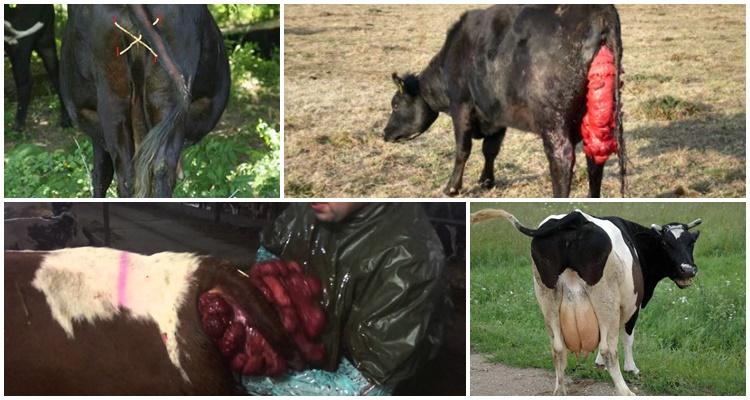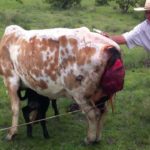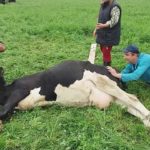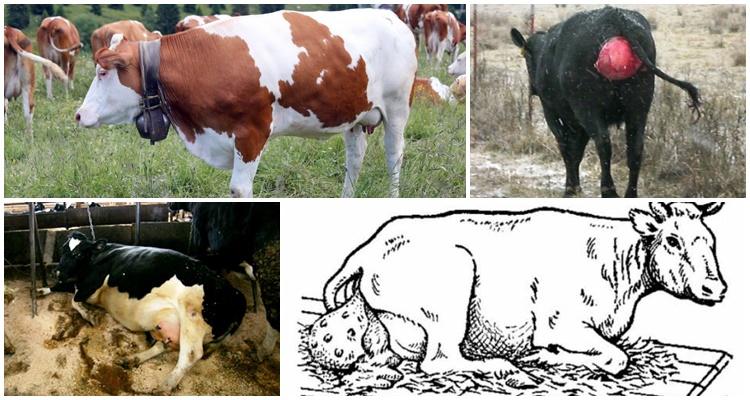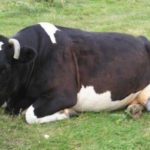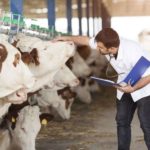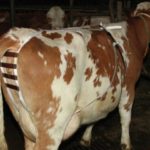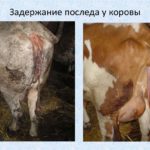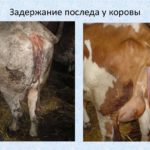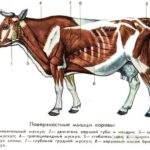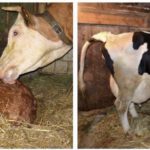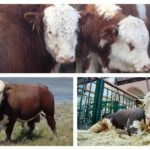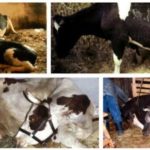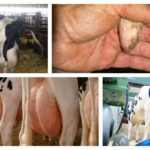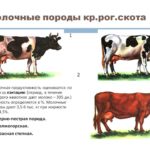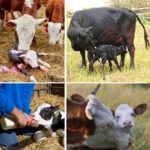Uterine prolapse is a rare pathology in cows that occurs after childbirth, but still the livestock breeder needs to be prepared for such consequences. Its future health and productivity, and sometimes even its life, depend on how correctly and timely assistance is provided to the animal. Let's look at what causes uterine prolapse in a cow, and what the animal owner needs to do about it.
Types of loss
In this postpartum pathology, there are 2 types - partial and complete prolapse of organs - the uterus or vagina.Vaginal prolapse occurs in pregnant females when there are several weeks left before giving birth, uterine prolapse occurs after childbirth.
Partial prolapse may develop due to laxity of the ligaments as a result of cows being kept on sloping floors, lack of exercise, or time spent walking. Prolapse looks like this: when a cow is lying down, part of the vagina comes out of the genital slit, which retracts on its own when the animal stands up. In some individuals, prolapse may occur every pregnancy.
If the prolapse is complete, the uterus is a red, cone-shaped formation that extends outward from the cow's body. Uterine prolapse is a continuation of this process, which can also be partial or complete.
Causes of the problem
Uterine prolapse in cattle often occurs as a complication of childbirth. The age of the animal contributes to it: in young cows this organ is still elastic, in old cows, which have given birth to 8-9 calves, it loses its elasticity and falls out. The causes of complications are diseases that are associated with intrauterine development of the fetus, its incorrect or rapid exit, difficult childbirth, multiple pregnancies. Or a short umbilical cord of the fetus, which pulls the uterus along with it. Often the organ may fall out when the placenta comes out.
Uterine prolapse after calving can occur due to poor nutrition, lack of magnesium, calcium, zinc and other mineral elements in the diet, or excess protein. The problem may arise due to infections the animal suffered during the dry period, gastrointestinal diseases, lack of active movements, or late start-up.
The reason that the uterus has come out may be a combination of factors during childbirth, such as poor moisture in the birth canal and the rapid passage of the fetus through it.
Because of this, negative pressure arises in the uterine cavity, under the influence of which the organ is pulled out. Other factors that can lead to uterine distension are an increase in intra-abdominal pressure due to rumen swelling, overfeeding, and colic. Often in this case, labor may be somewhat premature or complicated. Hypocalcemia can also be the cause of prolapse, and after giving birth the cow lies down, does not get to her feet, and does not understand her head.
Signs and symptoms
It is difficult not to notice that the uterus has prolapsed - the organ is large, pear-shaped, and if completely prolapsed, it can hang down to the cow’s hocks. At first it has a bright red color, but when left outside the body for several hours it becomes brown and sometimes acquires a bluish color. Traces of the placenta may be visible on the surface of the uterus, since it is turned outward. Sometimes it happens that the bladder and part of the rectum prolapse along with the uterus, but such cases are usually rare.
How to treat uterine prolapse in cows
Treatment should be started immediately as soon as the problem is discovered. You cannot hesitate; over time, the likelihood of developing necrotic processes and sepsis increases. If you do not immediately help the animal, it may die from internal infection.
Reduction is done under local anesthesia. First of all, you need to position the cow so that its hind end is slightly raised. To disinfect, treat the entire surface of the uterus with a 1% solution of potassium permanganate. After this, particles of the placenta are easier to remove.Then the uterus must be examined to identify possible necrotic foci that need to be treated with iodine. If tissue necrosis has spread greatly, the best solution is to remove the organ.
A veterinarian must insert the organ into the body cavity, and he must also take measures to prevent inflammation - endometritis and mastitis. Sometimes uterine prolapse occurs during childbirth, then there is a calf in it. If this happens, you need to remove the fetus from the uterus, separate the placenta, treat the uterus with antiseptic agents and set it back. You may need stitches to prevent the prolapse from happening again. After the end of the event, the animal is prescribed antispasmodics and antibiotics. Subsequent treatment should be aimed at enhancing uterine tone and preventing the occurrence of inflammation. This is achieved by using hormonal medications and antibiotic drugs.
Dangerous consequences
Necrotic changes in uterine tissue are the reason for its surgical removal. This is often the only option left to save the animal. This is a serious pathology, and even timely and competently performed uterine reduction does not guarantee that the cow will not develop uterine diseases.
The further reproductive use of the cow depends on the success of veterinary measures. Sometimes animals after such an operation remain infertile and are culled.
Prevention
During a cow's pregnancy, the owner needs to check the diet and correct any errors in feeding. Concentrates should be no more than half of the total volume of feed; mineral and vitamin supplements are required, as well as the introduction of calcium and protein, for example, from legumes. 1-2 months before calving, reduce the calorie intake.Before calving, introduce feed that the animal will eat during the period of feeding the calf.
During pregnancy, the cow should be in a clean, ventilated, bright and warm room. Any deviation from the norm in the conditions of maintenance and care will increase the likelihood of a problem. The animal should not be allowed to get sick during pregnancy, especially with infectious diseases.
Since it has been established that weakening of the ligaments of the limbs plays a major role in the development of this pathology, a pregnant cow should be kept in a stall with a flat, rather than sloping, floor. In this case, the load on the legs is distributed evenly, and problems do not arise.
It is important that the cow is delivered by a person who has the necessary knowledge and experience. It is not always the case that an ordinary person, even one who has kept cows for many years, will be able to help an animal during rapid or multiple births.
Uterine prolapse in cattle after calving is an uncommon occurrence, but it requires immediate intervention by the breeder and veterinarian. Treatment should only be carried out by a qualified doctor; doing it yourself is extremely problematic, and can also cause even more harm to the animal.

